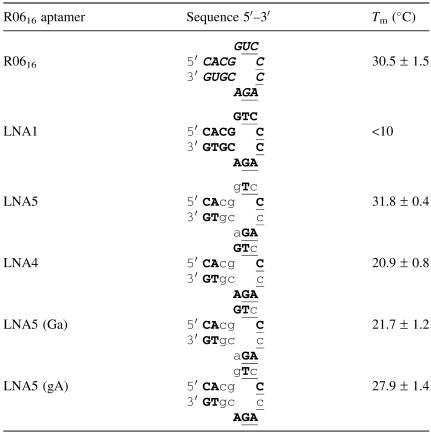LNA/DNA chimeric oligomers mimic RNA aptamers targeted to the TAR RNA element of HIV-1. Darfeuille Fabien, Hansen Jens Bo, Orum Henrik, Di Primo Carmelo, Toulmé Jean-Jacques. Nucleic Acids Res. 2004;32:3101–3107. doi: 10.1093/nar/gkh636.
The publishers would like to apologize for the incorrect formatting used in Tables 2 and 3. Correctly formatted Tables 2 and 3 are given in full below.
Table 2. Sequence and melting temperature (Tm) of LNA/DNA derivatives complexed with miniTAR.
Capital letters in bold italic represent RNA bases, capital letters in bold within an aptamer sequence represent LNA bases and lower case letters represent DNA bases. Underlined positions are nucleotides complementary to those of the TAR loop. Melting transitions were performed as described in Materials and Methods. Tms are the average and standard deviation of at least three independent experiments.
Table 3. Sequence and melting temperature (Tm) of LNA/DNA chimeric antisense oligonucleotides complexed with miniTAR.
| R0608 antiloop | Sequence 5′–3′ | Complex with miniTAR Tm (°C) |
|---|---|---|
| Antiloop LNA5 | 5′-gTcCcAGa-3′ | 31.9 ± 0.7 |
| Antiloop LNA5 (Δga) | 5′-TcCcAG-3′ | 30.5 ± 1.2 |
| Antiloop LNA5 (gc) | 5′-gTcCcAGc-3′ | 27.5 ± 1.3 |
| Antiloop LNA5 (ct) | 5′-cTcCcAGt-3′ | >40 |
Capital letters within an aptamer sequence represent LNA bases, lower case letters represent DNA bases and underlined positions are nucleotides complementary to those of the TAR loop. UV transitions of aptamer–miniTAR complexes were monitored as described in Materials and Methods. Tms are the average and standard deviation of at least three independent experiments.



